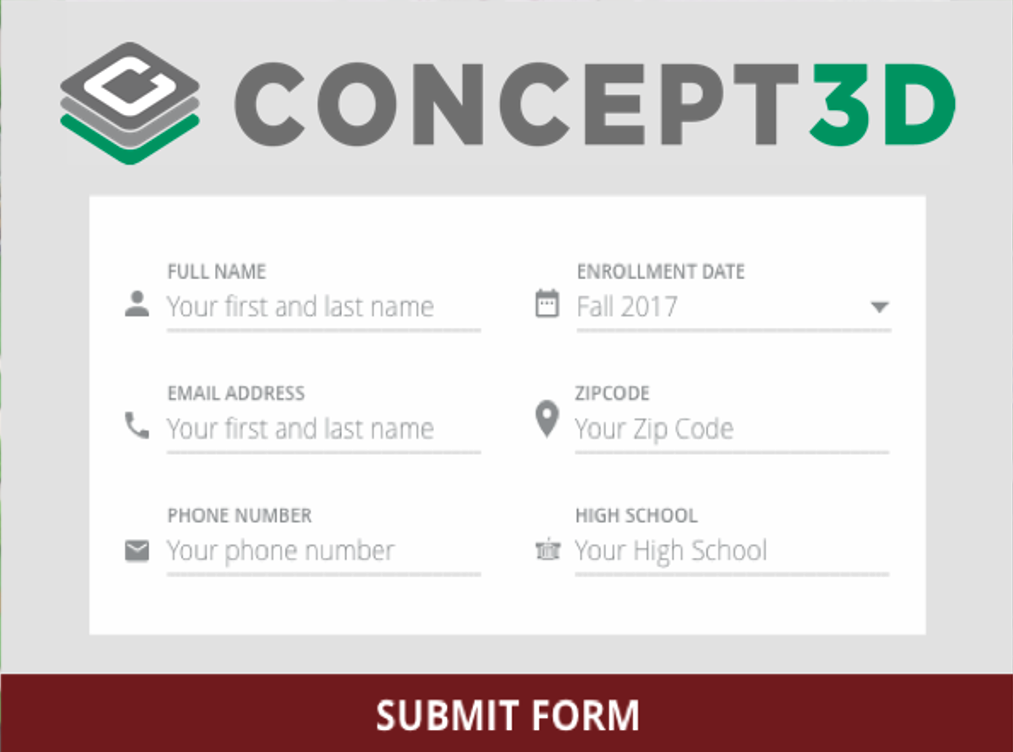It’s about more than just showing your space. In modern digital marketing and sales, everything is connected. The best custom interactive maps don’t just stand on their own. However, they fit perfectly into this marketing ecosystem.
In other words, custom interactive maps are much more than wayfinding tools. They’re conversion opportunities, interlinking with your other marketing channels and creating leads for your system. For your audience, they’re the perfect opportunity to have a conversation with your business.
That might mean notifications that tell your map visitors important information or a promotion related to their spot on the map. Additionally, it might mean calls to action that drive toward event or webinar registration. In this article, we’ll connect the need for conversion-based tactics to the opportunities custom interactive maps and virtual tours provide.
Conversions in Modern Digital Marketing
You might have heard the term conversion optimization. The marketing thought leaders at HubSpot define it as follows:
“Conversion rate optimization, or CRO, is the process of enhancing your website and content to boost conversions. A high conversion rate means your website is well-designed, formatted effectively, and appealing to your target audience.”
Prioritizing your website and marketing efforts for conversions means getting more leads into your database. Additionally, those leads have a higher chance of turning into qualified leads and eventually customers.
Because they come in organically and you don’t have to pay for them (through SAT buys in higher education, for example), you lower your acquisition costs and increase your marketing ROI.
That’s not just a theoretical conclusion, either. According to conversion rate optimization studies,
- The average website conversion rate is just 2.35%. But the top performers are at around 11%.
- Top-converting companies spend at least 5% of their budget on conversion optimization.
- More than 50% of companies plan to increase the conversion optimization portion of their budget next year.
To keep up, you need to be strategic. As your competition begins to prioritize conversion optimization, it’s time to take a holistic approach. Additionally, the more specifically you build your marketing strategy around conversions, the more likely you will succeed in gaining interest, leads, customers, and market share.
The Evolution of Virtual Maps and Tours
So much for the general need. Let’s talk about how virtual maps and interactive tours fit into the equation.
They began as simple wayfinding tools, replacements for their physical counterpart. Can’t make it to a location? Check out the virtual tour instead. Looking for some quick guidance on where to go? Just take a look at the digital map.
The Importance of Interaction
As technology began to improve, so did the capabilities of these tools. The interaction part began to take center stage as multiple industries, with higher education, public attractions, and real estate at the forefront. This created more in-depth experiences for their audience. There was no need to create just a replacement, but create an enhancement of the physical counterpart.
Then, the age of conversions happened upon us. Over time, web presences across industries began to turn from digital billboard to interactive, integrated marketing tools.
That’s how we got where we are today: custom interactive maps and tours are no longer just one-way communication tools, but two-way streets. Additionally, they’re helping users to find the right spaces and have a conversation. These multi-layered opportunities can take a number of shapes, depending on the industry.
Conversion Opportunities Across Industries
All of the above, so far, is abstract. So let’s make it real. Conversion opportunities within custom digital maps can look different depending on what industry you apply them to. These are just some of the many examples:
- In higher education, virtual tours can include a pop-up registration form for a physical open house or campus visit. If prospective students and parents are intrigued enough to want to learn more, they’ll become more likely to make the trip.
- In the hotel industry, notifications can let users know about the current weather at their future vacation destination. That can be followed up with a call to action to the booking page, reducing friction from eye candy and dreaming about the trip to actually making the financial commitment.
- In the events industry, clients can review potential venues and intuitively request a conversation (or even live chat) with a venue representative. That allows them to ask specific questions related to the venue and the custom event they’re looking to host.
- In the logistics industry, warehouse operators can leverage the notification system inherent within their custom interactive maps to call out specific nuances and details at a given time. That helps potential clients looking to utilize the warehouse space to follow up, ask questions, and move towards closing the deal.
Of course, the variety of potential cross-industry purposes for these types of interactive wayfinding tools also influence the types of conversion opportunities they might offer.
For instance, virtual tours built for talent recruitment may allow for the ability to download a whitepaper on the company’s benefits and corporate culture. This makes follow-ups with high-end talent easier for HR. The opportunities are almost limitless.

How to Build Custom Interactive Maps With Conversions in Mind
Time to take action. The conversion opportunities for maps and tours online are significant, as long as you know how to leverage them. That means building your platform with conversions in mind from the moment you start to conceptualize it.
It starts with the planning stage. From the beginning, consider your map or tour from an audience perspective. Where could they benefit from next steps or information? Are there opportunities to provide supplemental content, maybe in exchange for contact information?
Don’t just guess, either. Walk through virtual maps and interactive tours with members of your target audience, and observe their behavior. Where do they stop, where do they seem unsatisfied, and where would it make sense for them to jump off for a conversion opportunity elsewhere?
Research, Research, Research
A bit of competitive research never hurts, either. Dig through other companies or organizations in your industries to get ideas of how their maps and tours are set up. Pay special attention to the conversion points they seem to prioritize as they seek to get their audience from first interest to becoming a lead or customer.
From there, it’s into the execution stage. As you build your map, you have to make sure you’re aware of the various conversion opportunities you may be able to include:
- In-text calls to action for descriptions of specific items on your map or stops on your tour.
- More graphic call to action buttons, either layered into the design or popping up at various spots in your map or tour.
- Integrated contact/lead forms that allow your audience to provide you their contact info (maybe for an event registration) without actually having to leave the map experience.
- Notifications that prompt your audience to go elsewhere if they want to learn more about a given topic or take that conversion step.
Of course, these are just some examples of what some map platforms can provide. Once you have an understanding of the possibilities, finding the right partner to match capabilities with your specific audience needs becomes crucial.
Finding the Right Partner and Platform for Your Conversion Needs
Conversions have become a crucial part of the online experience, and that extends into the wayfinding and virtual tour space. Is your online presence capable of matching that trend? The answer might well depend on the platform and partner you’re working with.
Take Concept3D as an example. Like most mapping platforms, we offer simple hyperlinking in the text of descriptions and tour stops. But you can also build more customizable, graphic buttons along the top bar of the map or tour that can be leveraged for calls to action. For both in-text links and these buttons, you can directly integrate form submissions for a more seamless user experience that avoids platform hopping.
Notifications are another possibility. Our custom interactive maps allow for activity notifications in their base package. The 360-degree tours can be custom-built as necessary. The goal: to turn our clients’ virtual maps and tours into conversion points.
So let’s talk. If you, like us, have begun to realize the importance and benefits of conversions in all forms of online content, you will need a partner who can work with you. Contact us to talk through your options, and how we can help to turn your wayfinding tools into significant down-funnel marketing and sales opportunities.

